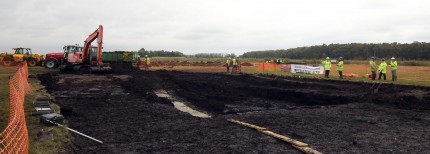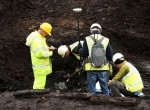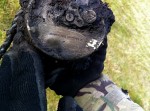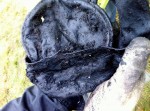
An excavation to recover a Mark 1A Spitfire which crashed in the Cambridgeshire Fens during a training flight on November 22, 1940, was suspended when a fragment of human skeletal remains was found. The excavation began on Monday and was slated to last a week. Permission was only granted because the pilot’s remains were believed to have been recovered in the immediate aftermath of the crash. Before excavation can continue, the coroner must examine the remains and give the all clear.
 Spitfire X4593 of the 266 Rhodesian Squadron Royal Air Force piloted by Harold Edwin Penketh was flying with other Spitfires over the fens when he suddenly broke formation and entered a precipitous dive. According to witnesses, the plane seemed to make a partial recover at around 2,000 feet above the surface, but it quickly turned back into the dive and crashed, hitting the ground at 300 miles per hour with its nose down and tail up. Pilot Officer Penketh was unable to deploy his parachute in time and was killed. He was 20 years old. A later investigation in the wake of the disaster determined that the cause was a physical failure of the airplane, possibly of the oxygen system. The RAF sent a recovery team who worked for a week to find Penketh’s body in the wreckage. The pilot’s remains were sent to his home in Brighton.
Spitfire X4593 of the 266 Rhodesian Squadron Royal Air Force piloted by Harold Edwin Penketh was flying with other Spitfires over the fens when he suddenly broke formation and entered a precipitous dive. According to witnesses, the plane seemed to make a partial recover at around 2,000 feet above the surface, but it quickly turned back into the dive and crashed, hitting the ground at 300 miles per hour with its nose down and tail up. Pilot Officer Penketh was unable to deploy his parachute in time and was killed. He was 20 years old. A later investigation in the wake of the disaster determined that the cause was a physical failure of the airplane, possibly of the oxygen system. The RAF sent a recovery team who worked for a week to find Penketh’s body in the wreckage. The pilot’s remains were sent to his home in Brighton.
 The exact location of the crash was lost over the years. It was rediscovered this August when archaeologists from Cranfield University Forensic Institute did a geophysical survey of the area. The Spitfire crashed in Holme Lode in the Great Fen, a waterlogged, peaty environment ideal for the preservation of organic materials. When it hit the ground it created a large crater that immediately began to fill with the water, so the unique preservative powers of peat were at work from the very beginning.
The exact location of the crash was lost over the years. It was rediscovered this August when archaeologists from Cranfield University Forensic Institute did a geophysical survey of the area. The Spitfire crashed in Holme Lode in the Great Fen, a waterlogged, peaty environment ideal for the preservation of organic materials. When it hit the ground it created a large crater that immediately began to fill with the water, so the unique preservative powers of peat were at work from the very beginning.
 With the fenland water table rising and this year being the 75th anniversary of Battle of Britain (July 10th – October 31st, 1940), archaeologists were keen to recover whatever they could from the Spitfire as quickly as possible. Excavation began on Monday, October 5th, led by Oxford Archaeology East with the help of volunteers from the Great Fen Archaeology Group and from the Defence Archaeology Group, an exceptional initiative that teaches
With the fenland water table rising and this year being the 75th anniversary of Battle of Britain (July 10th – October 31st, 1940), archaeologists were keen to recover whatever they could from the Spitfire as quickly as possible. Excavation began on Monday, October 5th, led by Oxford Archaeology East with the help of volunteers from the Great Fen Archaeology Group and from the Defence Archaeology Group, an exceptional initiative that teaches  injured servicemen new professional skills in field archaeology. The volunteers used metal detectors around the crash site to locate any debris that may have been scattered in the crash. Every find was flagged and scanned so that a complete 3D model of the site can be made which will allow experts to better understand the angle and impact of the crash. The team hoped to recover key parts of the plane, like the its Rolls Royce Merlin engine, its armaments, that would add more information to the greater picture.
injured servicemen new professional skills in field archaeology. The volunteers used metal detectors around the crash site to locate any debris that may have been scattered in the crash. Every find was flagged and scanned so that a complete 3D model of the site can be made which will allow experts to better understand the angle and impact of the crash. The team hoped to recover key parts of the plane, like the its Rolls Royce Merlin engine, its armaments, that would add more information to the greater picture.
 The peat was stripped in spits and on the second day the team uncovered the impact crater just over two feet under the surface. By the end of the day they had recovered some engine wiring, a piece of the fuel tank and the pilot’s headrest. On the third day they found ammunition, two more pieces of the fuel tank, part of the engine starter motor, the cover for the pilot’s headrest and part of the cockpit which was deliberately broken open by the RAF team who recovered P/O Penketh’s body. On day four they found the rest of the engine starter motor, one of the Spitfire’s lights, the pilot’s leather helmet in very good condition and the fragment of bone that immediately stopped all work.
The peat was stripped in spits and on the second day the team uncovered the impact crater just over two feet under the surface. By the end of the day they had recovered some engine wiring, a piece of the fuel tank and the pilot’s headrest. On the third day they found ammunition, two more pieces of the fuel tank, part of the engine starter motor, the cover for the pilot’s headrest and part of the cockpit which was deliberately broken open by the RAF team who recovered P/O Penketh’s body. On day four they found the rest of the engine starter motor, one of the Spitfire’s lights, the pilot’s leather helmet in very good condition and the fragment of bone that immediately stopped all work.
 The coroner has now given the go-ahead to continue excavation. Friday will be the last day of the dig.
The coroner has now given the go-ahead to continue excavation. Friday will be the last day of the dig.
The Oxford Archaeology Flickr page has a wonderful collection of photographs of the dig arranged in albums, one for each day of the excavation. You can also read a daily roundup of discoveries on the Oxford Archaeology website. A selection of finds will be on display at Holmewood Hall on Saturday, October 17th, and the dig is being filmed by the BBC for a program that will first air on November 8th, Remembrance Sunday.